Wild Hog Traps
Trap Types
Box Trap
Box traps can be several different shapes and sizes. They are often built by the person who plans to use them. Box traps can be completely enclosed or have an exposed top. Their size is usually determined by the person making it, there is no uniform size. Most box traps are 4ft wide and 8 ft long with sides that are 3ft to 4ft tall. It is important to remember that hogs can climb, so a top is recommended. These traps must be anchored to the ground – typically using T-posts.
Pros:
- Easy to construct
- Can be easy to transport
Cons:
- Can only catch limited number of hogs
- Can catch non-target animals
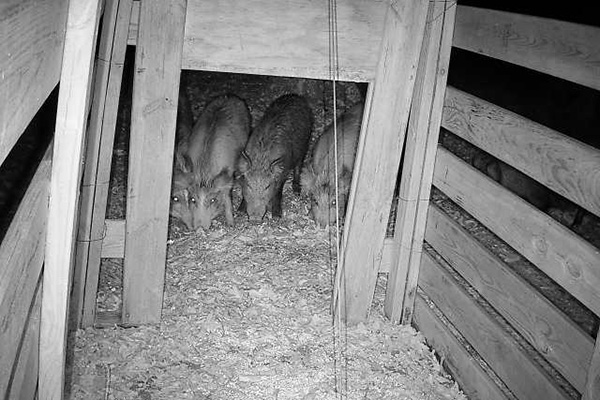
Pigs hesitant to enter a box trap. (Photo by Andrew Jamison)
Corral Trap
Corral traps are effective traps for catching large groups of hogs. They are generally made using 20-ft by 5-ft livestock panels that have 4-in by 4-in mesh. These panels are then secured using steel T-posts. Their size can be modified to accommodate larger groups of hogs. These traps require more effort to setup and can be more expensive to assemble, depending on the materials used. These traps can be paired with a trap door or rooting gate. They can also be paired with a camera that can be connected to a gate so the gate can be dropped from an app. Jager Pro makes live streaming cameras that grant the user access to the gate controls.
Pros:
- Catch large number of hogs
- Remotely controlled doors can allow user to drop the gate once all hogs have entered
- Size can be modified as needed
Cons:
- Cost – can get more expensive, especially with addition of camera and remotely controlled gate
- More labor-intensive setup
Cage Trap
These traps are generally made using heavy-gauge wire livestock panels that are welded onto a steel frame. They can be a variety of sizes and shapes. Some are made in a circular shape, which allows for easier transport since they can be rolled. If the cage trap's height does not exceed five feet, a top is recommended. There is no need to have a floor on these traps. To further secure the trap, T-posts can be secured to the panels using wire.
Pros:
- Wire panels may appear more "open" to the animals and may increase their willingness to enter
- Most designs allow for easy transport and setup
Cons:
- Catch size is limited
- Traps that are enclosed may not allow non-target animals to escape
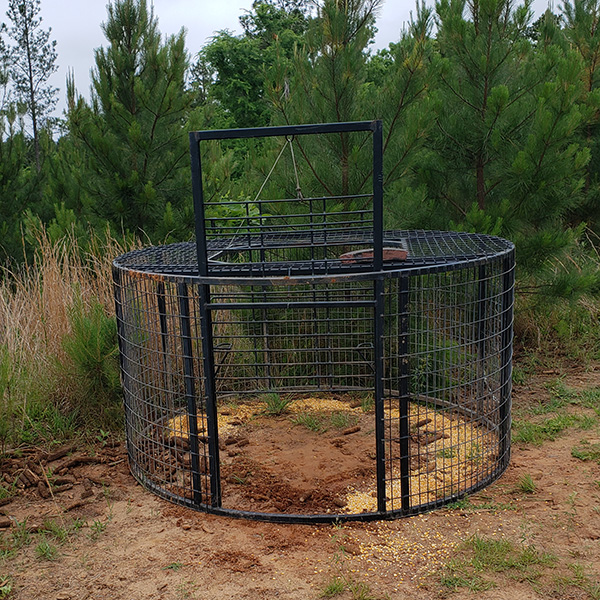
Example of a round cage trap. (Photo by Bo Martin)
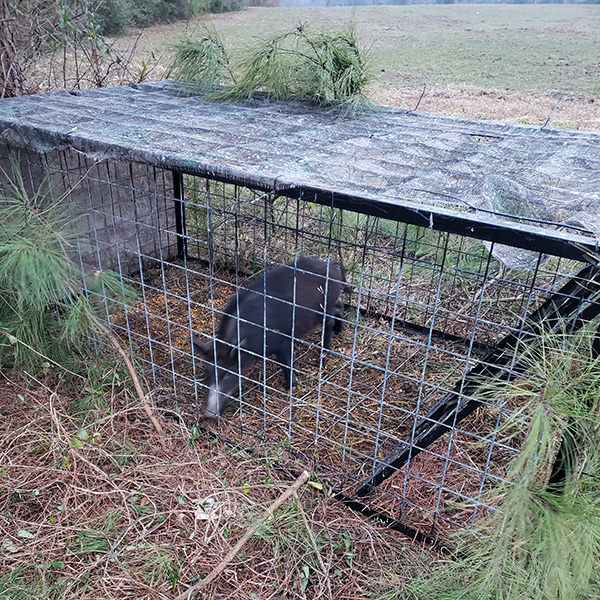
Pig caught in a cage trap. (Photo by Bo Martin)
Pig Brig Trap Systems
The Pig Brig Trap System consists of a circular net attached to ten T-posts that are driven into the ground. This trap is easy to setup and can be done by one person. Since the trap is a net, it can be bundled up for easy storage. This trap allows hogs to enter under it but they cannot get out. This trap does not require a door or trigger mechanism. These traps come ready to setup and cost from $2,500 to $3,000.
Pros:
- Easy setup
- Easy storage
- Continuous trapping – hogs can keep entering trap
Cons:
- More expensive than some traps
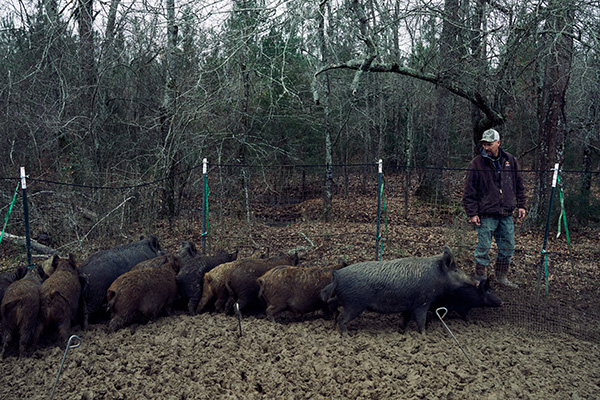
Pigs caught in a Pig Brig trap. (Photo provided by Pig Brig)
Trap Door Types
There are a variety of trap doors that can be paired with the various types of traps. Similar to the traps, the choice of door depends on the goal of the person trapping. Some doors are cheaper but can catch fewer hogs, others are more expensive but can give the user more control.
Single-Catch Doors
The drop style doors, also known as guillotine style, are the most budget-friendly doors. These doors are generally constructed using lumber and plywood. These doors are generally constructed using 2-inch-by-4-inch lumber and 2-inch-by-2-inch lumber secured to the trap. A ¾ inch piece of plywood generally is used as the door. After the animal triggers the trap, the door falls and no other animals will be caught.
Multi-Catch Doors
As the name implies, these doors can be used to catch multiple hogs. There are a few options for those who are looking to target large groups of hogs.
Rooter Door
Rooter doors are multi-catch doors that allow hogs to enter a trap but they cannot get back out. These doors should be left open until the hogs are comfortable entering a trap. Once they are comfortable, the door can then be lowered and they will enter the trap. The door will then fall behind them and they will not be able to get out. These are usually made using steel. They can be purchased fully constructed.
Saloon Door
Saloon doors are similar to rooter doors. They must remain open until the hogs are comfortable with entering the trap. The gates are held open using stakes that are driven into the ground. These stakes are then removed and the hogs can enter. Once they have entered, the doors will shut and they will not be able to escape. These doors rely on springs and are activated using a tripwire. Once they have been activated, other hogs can still enter the trap but the ones in the trap cannot get out.
Trigger Mechanisms
Root Stick
Root sticks are made using rebar or wooden sticks. When making a root stick using wooden sticks, two sticks need to be used. Two sticks are driven into the ground at a 45-60 degree angle facing away from the entrance to the trap. A second stick is then tied to the top of the drop door using rope. To set the trap using a root stick, lift the door and wedge the stick with the rope tied to it under the horizontal sticks. The door should remain open upon releasing the rope. The stick should be placed in a pile of bait, which will encourage the hogs to trigger the mechanism. Once the horizontal stick is moved while the hogs feed, the door will fall and prevent the animal from leaving. This trigger is often paired with a sliding door. Once the trap is triggered, no other hogs can enter.
Trip Wire
As the name of this trigger suggests, a trip wire is made using a length of wire that runs across the back of a trap. The wire should be 12-20 inches above the ground. The wire runs from the back of the trap, over the side of the trap, across the trap, then finally attaches to a release mechanism. A rope holds the door open until the hogs activate the trip wire, causing the gate to fall. The trip wire should be in front of the bait. If the hogs do not trigger it, consider a different material for the wire, such as braided fishing line, to make the wire more hidden. Once triggered, the door falls and the animals inside cannot get out.
Remotely Triggered Traps
Companies such as JagerPro offer remote trigger mechanism options that can be controlled from an app. The gate controls are connected to a camera that gives live images of the trap. When hogs are in the trap, the door can be dropped using an app. This allows the user to catch an increased number of hogs.
Where To Set Traps
The trap placement can be crucial for successful trapping efforts. There are many factors to consider when choosing a location to place a trap.
Activity
Look for signs of hog activity in an area. You can read more about the signs of wild hogs here. Keep in mind that an area that has a lot of activity does not mean it is an optimal place for a trap. Look for paths they use for travel or areas where they may spend time resting. Hogs tend to stick to shaded areas that have thick vegetation. They also tend to stick close to sources of water. Finding areas that are easy for them to access will likely lead to more successful efforts. The hogs will tell the trapper where they are, the trapper just needs to read the signs.
Accessibility
The accessibility of the trap location should also be taken into consideration. The trap will have to be monitored and baited regularly. Once the animals are trapped, they must also be dispatched and removed. The trap also has to be setup, so ensure the spot has enough room for a trap.
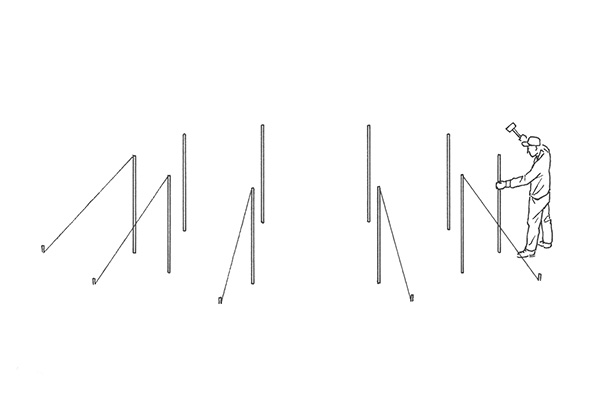
Diagram of the setup for a Pig Brig trap. (Photo provided by Pig Brig)
The Trapping Process
Bait Selection
The bait is an important element when drawing hogs into the trap. After a suitable spot for a trap has been found, spread some bait out without the trap first. It is important to get them used to bait before you set the trap to increase the likelihood that they enter the trap for the bait. Whole kernel corn is often used to trap hogs. The corn can be fermented or topped with a sweet attractant, such as molasses. Visit the bait site daily, if possible. This will help determine if hogs are visiting a spot and a trap can be set up. These bait sites are also more effective when paired with a trail camera to determine how many hogs are visiting a spot. Multiple baited sites can be established to determine where the hogs are. Once one of the sites has activity, the process of pre-baiting and trapping can begin.
Pre-Baiting
A spot must be pre-baited before a trap is set up. This will get the hogs used to corn and motivate them to enter a trap once it is set up. After the trap has been setup, it is recommended that you wait 1-2 weeks before setting the trap. This allows the hogs to get more comfortable entering the trap and increases the chances of catching the whole sounder. When using a remotely triggered trap, it is still important to determine how many hogs are showing up by monitoring them regularly. The door can be dropped after all the hogs that have been spotted enter the trap. The Hog Brig traps also require pre-baiting to get the maximum number of hogs. The net is lowered after the hogs have gotten used to entering the area. Drop the net down far enough to let it touch their backs. It can then be lowered even further, then finally it can be set.
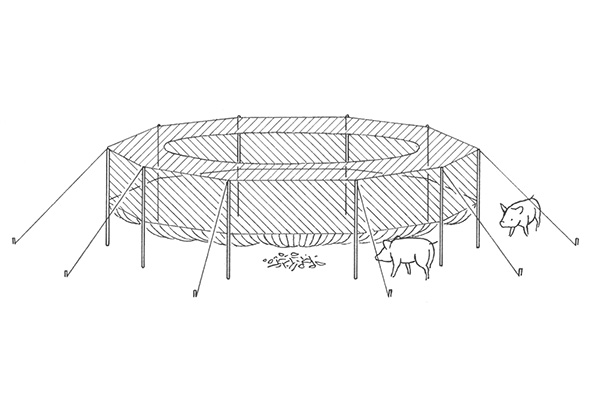
Diagram of pig brig system being pre-baited. (Photo provided by Pig Brig)
Pre-baiting Steps
- Make sure the door is propped open and will remain that way until the trap is set – tie up a drop door securely, use stakes to prevent saloon doors from closing
- Place around the trap and leading into the trap
- Place a larger pile of bait inside the trap close to the entrance
- Ensure the hogs have a constant supply of corn to ensure the hogs continue to visit the site
Bait Choices (used by themselves or together)
- Shelled Corn (Dry, Fermented)
- Grains
- Sweet potatoes
- Overripe Fruit
- Molasses
Corn works well as an attractant for hogs in most places. It can also be purchased from several different stores. It is easy to transport, easy to find for sale, and easy to store. If the hogs are visiting a site but do not seem interested in corn, try a different bait. If you want to reduce the amount of corn used to bait hogs, a bait bucket or bait barrel can be used. These are buckets filled with corn that are tied to trees or stakes. They are filled with water and corn, which can prevent non-target species from accessing bait. Game feeders can also be used, but they can be expensive and are harder to setup than simply just throwing corn out.
Bait Placement
Once the hogs have been baited and the trap has been set up, bait placement must be taken into consideration. While pre-baiting, place a trail of bait into the trap so the hogs follow it and enter the trap. Once they know the trap has bait, place a large pile of bait away from the trigger. Place a smaller pile of bait on the trigger mechanism. The hogs will likely start at the large pile of bait, then move on to the smaller pile after it has been eaten. This means that more hogs will have entered the trap, and the trap won’t be triggered until they have all moved to the secondary pile. When using a remotely triggered gate, this is not as important.
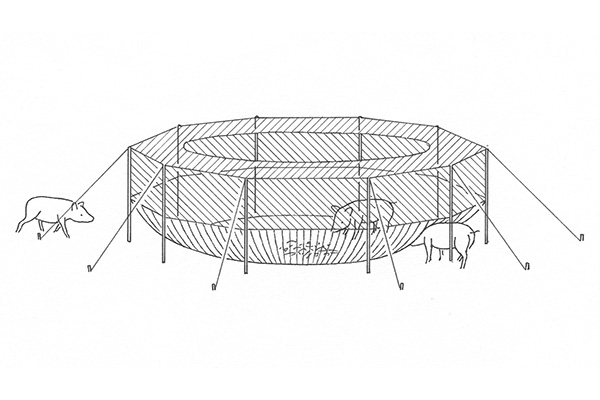
Diagram of pigs being attracted to bait in pig brig system. (Photo provided by Pig Brig)
Setting the Trap
Once the trap has been regularly getting hogs and the number of hogs has been determined, the trap can be set. The trap needs to be checked daily once set. It is inhumane to leave animals in a trap for too long and it increases their chances of escaping. Once the trap is triggered and the animals are caught, they can then be euthanized.
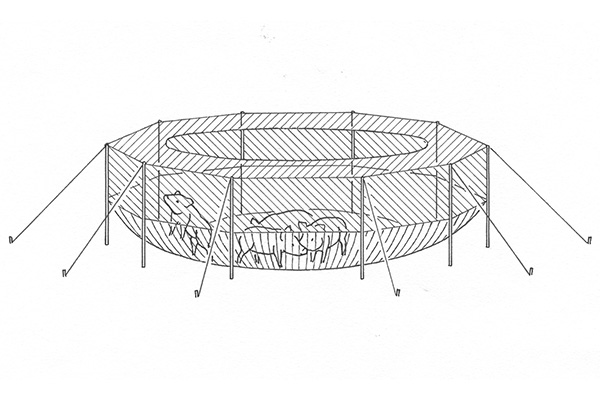
Diagram of Pigs being trapped in pig brig system. (Photo provided by Pig Brig)
Euthanizing
Use caution when approaching a trapped hog. Hogs are very strong and can be aggressive in a trap. Approach slowly and downwind if possible. Hogs will charge at the sides of the trap and run around if spooked. Minimizing the stress on the animal is not only more humane, but it will also prevent the animals from damaging the trap.
When a hog is trapped, it should be dispatched in a humane manner. Rifles are often used to dispatch the animal. This can be done with a .22 long rifle or larger caliber. The shooter should aim for the brain cavity to ensure a quick and humane death. The shot can be placed 2-3 inches above the center point between the eyes or directly between the eye and the ear.
Do not insert the barrel of the rifle into the cage. The hog may charge it and cause injury to the shooter. It is best to shoot through the fence on the trap or from an elevated position (such as the bed of a pickup truck).
Non Target Animals
Occasionally non-target animals will enter a trap. Hogs are not the only animal enticed by bait. Some of these animals will get out of the trap on their own. For this reason, it is often recommended that open-topped traps are used. This is another reason traps must be checked regularly, to make sure non-target animals are not harmed. If you are worried about non-target species being caught, then trap type needs to be considered. Some traps allow other animals to exit on their own. If you are opening a door to let a non-target animal out, exercise caution. Wild animals can be unpredictable and sometimes dangerous.
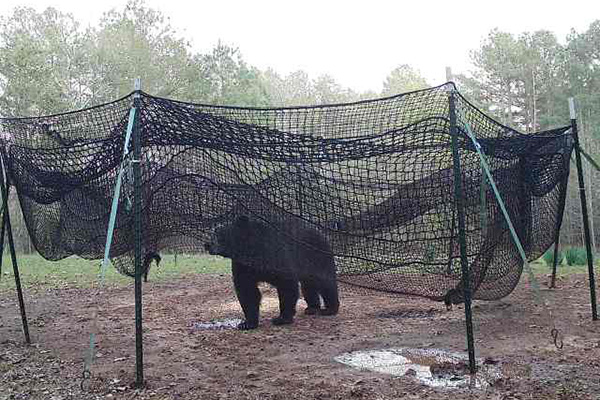
Black bear inside a Pig Brig trap. (Photo by Andrew Jamison)
